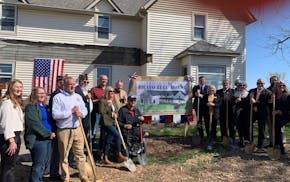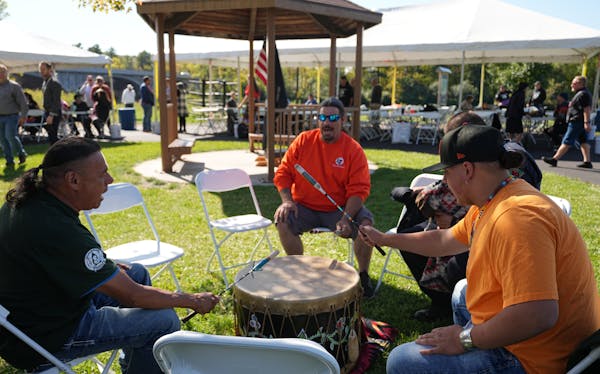SUPERIOR, Wis. – Wild and lush Wisconsin Point, a forested sandbar that straddles Lake Superior and Allouez Bay, long has been treasured for swimming, smelting and hiking.
But for centuries, a thriving community of Anishinaabe lived there, long before and after the nearby Fond du Lac Reservation was established. And they were buried on the 3-mile peninsula until nearly 200 graves were exhumed to make way for a burgeoning steel industry in the early 1900s and villagers were forced to leave their homes.
But now, thanks to efforts by leaders of the Fond du Lac Band of Lake Superior Chippewa and an Indigenous member of the Superior City Council, sacred burial grounds are back under the ownership of the Lake Superior Chippewa, part of its systematic effort to reclaim its homelands. It aligns with a cultural shift developing nationally, as Indigenous land reclamation and stronger protection of Native American graves is a priority of the Biden administration.
It's only in recent years the tribe has been able to legitimately sit at the table, but it has never stopped fighting to restore its land on the point, said its leader, Kevin Dupuis.
"We are obligated to our ancestors," he said. "The fights they had never ended. We just picked them up."
An 'atrocity' committed
A 1913 map of Superior and its surrounding waterways declares it "the new steel center." Indeed, U.S. Steel wanted to build iron ore docks along Wisconsin Point, and in 1918 used federal money intended for the Fond Du Lac Band to remove bodies, ship them up the Nemadji River and rebury them in mass graves at Superior's St. Francis Cemetery.
The bodies of Chief Joseph Osaugie and another leader, Maangizid, both signers of the 1854 Treaty that ceded northeastern Minnesota land to the government and established reservations and rights for area tribes, were among those exhumed.
But the sandy point wasn't suitable for industrialization, and the docks were never built. Some Ojibwe families fought U.S. Steel in court over the land, but the company prevailed and became owner in the 1920s. Eventually, most families left, including the grandmother of Hermantown resident Bob Miller, who was born on the point in 1913 and whose family left when she was 8. Then, his grandmother Irene McCauley was sent to a Native American boarding school in Odanah, Wis. It resulted in loss of her Ojibwe language and many traditional cultural practices, said Miller, a retired Duluth teacher of Native American studies and history.
But she always wanted to return to the peaceful home where her family fished for herring and she played with dolls made from deer hide.
"She remembered it, and she wanted it back," said Miller, a seventh-generation descendant of Osaugie.
"The atrocity" of what U.S. Steel did, said Chantal Norrgard, assistant professor of First Nation Studies at the University of Wisconsin-Superior, is part of settler colonialism.
The development of the port of Duluth and Superior was incredibly important to captains of industry and the federal government, and the cession of land by the Ojibwe through its treaties was crucial to those plans, she said.
A city accountable
Last year, after a radio-sponsored city medallion hunt ended with searchers rooting through the Wisconsin Point burial grounds, Superior City Council member Jenny Van Sickle and Mayor Jim Paine met with Fond du Lac leaders about returning the land. They were skeptical it would get done, Van Sickle said, because they've seen politicians make promises before.
But Van Sickle, a member of the Central Council of Tlingit and Haida Indian Tribes and Sitka Tribe of Alaska, began the arduous process, and at an August ceremony, the city officially transferred the cemetery on the point back to the band. Superior's St. Francis Xavier Church also transferred to the Fond du Lac band the land where bodies were re-buried along the Nemadji River, a rundown plot where erosion has led to bones resurfacing and washing into the water.
"The takeaway is your elected officials can do more; you can push them to do more," Van Sickle said. "Superior isn't the only one facing [such issues]. We were just the city willing to be accountable."
Trauma remains
In the Twin Ports, the Fond du Lac band considers Wisconsin Point and west along the St. Louis River about two dozen miles to the reservation a "cultural corridor" steeped in significance to the Anishinaabe.
Dupuis, who for years has made monthly treks to Fond du Lac burial grounds in Duluth and Superior to offer tobacco to his ancestors, said reclaiming the land that holds them matters, but the trauma remains. And it's not just from U.S. Steel's actions a century ago, he said. In 2017, the Minnesota Department of Transportation dug up burial grounds in western Duluth as they started work on a bridge project.
"The footprints of Indigenous people are all over the state of Minnesota," Dupuis said, and tribes know locations of culturally important sites. "We will tell you where these significant places are. Pick up the phone."
The desecrations have at least led to improved communication with state agencies and heightened visibility of Indigenous people, said Thomas Howes, a descendant of Maangizid and the natural resources manager for the band.
"It's important for the psyche of Indigenous people to be acknowledged," he said, "so you're not just this ghost of your ancestors."
'A shared commitment to healing'
The band of 4,200 members believes many more bodies remain buried on Wisconsin Point, as only those with marked graves were removed. It hopes to restore more land, to connect what it owns on the end of the point with the cemetery. In 2017 it reclaimed about 12 acres of surplus land from the U.S. Army Corps of Engineers. It wants to preserve and protect what is there, and find a way to educate those who come upon the site.
The cemetery is marked by a sign toward the end of the point, and tall cement barriers surrounding a memorial plaque act as protection and resting places for the gifts of tobacco, stones, flowers and dolls left by visitors honoring Anishinaabe spirits. Over the years, offerings have been stolen, said Miller, who regularly maintains the site.
"They don't understand why all of this is out here," he said. "All of these things mean something to someone."
The band will apply to put the reclaimed land into federal trust, a lengthy process that makes it part of the reservation. The Biden administration is committed to restoring tribal homelands and is working to quicken the process, along with modernizing regulations that protect Native American graves, said Bryan Newland, assistant secretary of the Office of Indian Affairs in the U.S. Department of Interior.
Newland, who attended the August land transfer ceremony in Cloquet, said the work between Superior and the band "is a really good example of what happens when there is a shared commitment to healing … and when communities value tribes."

Hennepin County Attorney inks contract with D.C. law firm to prosecute trooper Londregan case

Defense attorneys in Feeding Our Future trial cast doubt on FBI's meal fraud investigation

Protesters hold dueling Gaza rallies at University of Minnesota

Overdose deaths spike after incarceration, but Minnesota jails lack treatment

